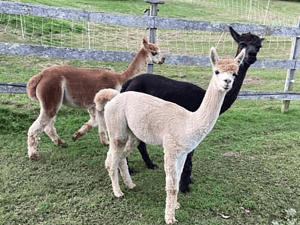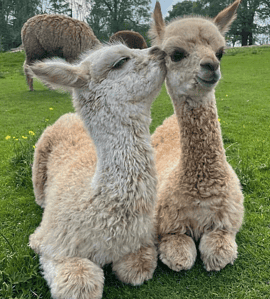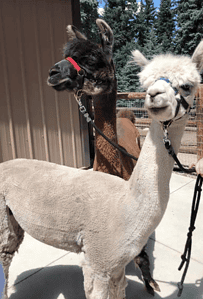With their unusual looks and soft fur, alpacas are one of the more unique animals that you will see on homesteads. If you are considering starting an alpaca farm, you will find that they are interesting, friendly, gentle and beautiful creatures. They are easily domesticated and easy to keep and feed.
While they aren’t considered guardian animals, they are quite useful around your property. Additionally, you can earn money raising alpacas. Learn about the purpose for raising alpacas and why you may want to consider them for your homestead. There are several reasons people raise alpacas.
Alpaca Farm
Why do people raise alpacas? If you are considering starting an alpaca farm for profit, you will most be interested in raising alpacas for wool and for breeding. Both of these are sustainable and renewable.
Alpaca Fiber
Alpaca fur is also called alpaca fleece or wool. It is soft and warm, and it is also waterproof. Alpaca is a hypoallergenic fiber. It will not make people itch like wool sometimes does. Alpaca fiber is harvested once a year by shearing the animal.
Alpaca farm owners and breeders will sheer the entire body. It will help prevent heat stress in the animals. They should be shorn yearly.
There are two types of alpacas, Huacaya and Suri. Both produce different types of fibers. Huacayas alpaca produce a soft, wavy fiber almost like sheep or teddy bear fur. The fibers are dense. Suri alpaca have silkier and longer fibers than Huacaya. They look almost like dreadlocks.
Breeding Alpacas
Some alpaca owners make money by raising excellent breeding stock. They will breed alpaca babies to sell. These are called crias.
They can also sell breeding rights with male alpacas which are called studs.
While a herdsire male may sell outright for $2,500, an alpaca farmer can sell the herdsire stud fee for $1,000. Herdsires are male alpacas with strong genetics and meets high standards.
In addition to the body, some things that factor into a herdsire is the uniformity of coloring and density, how the fiber crimps, and more.
Alpaca farms selling alpacas will spell out information about each animal. You will know if the animal is proven or unproven. You will also know if the animal is considered to be a non-breeder so you will know what you are buying.
Alpaca Meat
Homesteaders and hobby farmers will not raise alpaca to harvest for meat because their fibers are more profitable over time. It is not profitable to only raise alpacas for meat.
Typically, alpaca farm owners will slaughter them for meat when they are removing unproductive animals also know as culling the herd.
Alpaca meat is lean, tender, and delicious. It is low in fat and high in protein. It is one of the lowest cholesterol meats available.

Easy on the Land
People often choose alpacas over other animals because they are easier on the land. Alpacas do not have hard hooves. Instead, they have soft feet that won’t churn up mud in pastures. They also nibble the grass rather than pulling it up by the roots.
If you have a large pasture, consider raising alpacas.
Alpaca Manure
One of the side benefits of raising alpacas is their manure. Alpacas have the unusual habit of depositing their manure in only one or two places in the pasture. This makes manure collection easier for the farmer. Alpaca manure makes fantastic compost.
Hardy in Cold Weather
Alpacas are also very hardy, enduring very cold weather very well. They don’t need extensive shelter. A three-sided shed will do. They eat only grass and hay, and not very much of that.
Companion Animals
Alpacas make wonderful pets. They are friendly and easily trained. But it’s important to know that while a herd of alpacas can protect sheep, they aren’t known to be guardian animals for livestock. Also, a lot will have to do with the types of predators on your land. If you are looking for productive guardian animals, consider llamas. Learn about alpaca vs llama.

Is an Alpaca Farm Profitable?
Like many homesteading ventures, one key to having a profitable alpaca farm is to do your homework before you bring home any animals. You need to know if there is a market for your product in your area before you start writing checks, building fences, and buying livestock.
There are several ways to make money from your alpacas.
Raw Fibers
First, you can sell the fiber from your animals. The alpaca’s soft, fluffy fleece is sheared once a year. Alpacas can be true black, pure white, light silver grey, medium silver grey, light rose grey, fawn, medium fawn, dark brown, beige, and more.
Of course, you can sell the fleece itself, but when you do that, you will just about break even on the cost of keeping your animals.
If you can do some of the work to take the fleece further down the production line, you can sell your fiber for more and more money.

For instance, the raw fiber from your alpaca might be sold for about $3 per ounce, generating about $500 per animal. However, if you can wash and card the fiber to prepare it for spinning, you can charge more for your fiber.
Then, if you actually spin the fiber into yarn, you will make more money. If you use the yarn to make goods like hats, sweaters, mittens and scarves, you can earn even more cash. Therefore, how much money that you can make from alpacas depends on how much work that you want to put into preparing the fiber.
Breeding Alpacas
Another way to make money with alpacas is to breed and sell the offspring. “Crias” are the technical name for the alpaca babies.
Alpacas breed once a year and the females are pregnant for about 11 months. They give birth to a single cria which will nurse its mother for 6 to 8 months. Females are ready for breeding around 18 months of age and males are ready to breed at 3 years old.
If you practice careful breeding, your sale of crias can make decent money. Over time your reputation will grow. People will come to know that they have a quality animal when they buy from you.
Suri Studs and Huacaya Studs
You can also make money by buying an excellent male animal and allowing others to use him for breeding purposes. Alpacas are not bred through artificial insemination, so having a very good male with excellent genetics can earn your homestead money.
Culling for Meat
While there is not a “meat” version of the alpaca, when farmers cull their older animals, they will harvest meat from them. An adult alpaca yields about 60 pounds of meat. The meat is tender, low in fat, and quite tasty. In some areas, you might be able to sell it at a specialty meat market.
Like many homestead business ventures, alpacas will take some time to pay off. The investment costs of buying the original alpacas may take a few years to recover. These animals may not pay all the bills of the homestead. In time, however, alpacas can be a part of making your farm profitable.
Tours
You can also set up your farm for people to book a tour and be a destination for field trips, etc. This may be beneficial to attract people to your farm if you have items to sell.
How to Start an Alpaca Farm
Raising alpacas is similar to raising other livestock. They will need shelter from the elements, food, and water. Because of their easy-going temperament, they are among the best farm animals to raise.
If you want to start an alpaca farm, you’ll need to consider acreage, shelters, feeding stations and areas to maintain and sheer the animals.
How Many Alpaca Can You Raise on an Acre?
While it varies depending on your climate, many producers stock about 5 to 7 alpaca per acre of grazing.
Alpacas are only happy if they have at least one other alpaca around. They are herd animals and will get stressed if they have to be alone.
Alpacas need fencing that is at least 4 feet tall to keep them in. If you live in an area with large predators like bears, you may need sturdier, taller fencing.
Alpacas also need shelter from wet weather in the winter. A three sided shelter will work for males and females without crias. However, if you will have crias, a four sided barn is best to protect the little ones from bad weather. They also need shade for hot summer days.
In your barn, provide spaces to feed the alpacas. While they will forage, you can feed small amounts of alfalfa hay alpacas to only the pregnant and lactating females. The feed pans should be raised from the ground, at least a foot and a half apart.
You should include some smaller pens around your barn. Pens will make it easier to catch your alpacas. You will need to catch them for shearing, trimming toenails, and doing basic veterinary care.
The most common style of fencing for alpacas is high tensile electric fencing. The fence should have 4 – 7 strands of electric wire. The wires should be closer together at the bottom than at the top. Barbed wire fences are not suitable for alpacas. They will snag the fleeces of the animals.

Raising Alpacas
Caring for alpacas is relatively easy. Daily care includes feeding the alpacas twice a day and ensuring they have plenty of clean water. Alpacas eat relatively little as compared to other livestock. An adult animal eats only about 2 pounds of hay or grass per day.
They are considered to be high foragers and can handle browse.
Alpacas — along with llamas and sheep — are sensitive to copper. It is important they are not fed trace mineral products designed for cattle.
Daily feed intake should be 1.5% of their bodyweight. More is required for lactation and rapid growth.
Alpacas are sheared once a year. They also need their nails trimmed every 6 to 8 weeks. Depending on your area, your alpacas may need to be wormed monthly as well.
Alpacas live for about 20 years. This makes them productive for their fibers.
Where to Buy Alpacas
Before you can begin raising alpacas, you have to start with buying your first breeding pair. When looking for sellers of alpacas, you may want to start with the breed association in your area and state.
Start sending email messages and seeking out other farmers who raise alpacas in your area. There are also online marketplaces where you can check out the animals that are available in your area.
Remember that alpacas are not as common as many other kinds of livestock, so you may have to drive a distance to get your first few animals.
Take your time as you start looking into buying alpacas. In time, you will start to get a feel for what is a fair price and what is excessive. You’ll learn a lot about bloodlines and breeding too, if you start looking up family trees. The research process may take several months of study before you buy the first animal.
If you have never raised alpacas before, you probably want to start out with a much less expensive animal than you may buy in the future. You will probably make some mistakes as you learn, and it’s better to make a mistake on a less expensive animal than a pricier one.
Of course, it’s a bad idea to go too cheap either. Don’t buy animals that are less hardy or healthy in an effort to save money. You will find that the “savings” will probably be eaten up in vet bills and extra care to get sickly animals healthy.
Alpaca Farm Near Me
Before you buy an alpaca, you might want to go to some shows and check out the top animals in your area. Check out ” alpaca farm near me ” to see them close up. You want to develop an eye for what makes a quality, healthy animal before you start pulling out your checkbook.
You might also want to contact your county extension agent before you buy an alpaca. They may know breeders in your area that you haven’t yet run across. Also, there may be some government programs to assist you as you get started in alpaca farming.
While you can find alpacas that are less expensive, most animals of breeding age cost between $3,000 and $10,000 per animal. Costs for alpacas vary depending on the animal’s age, conformation, lineage, and fiber quality.
Alpaca Farming Origins
Alpacas originated in the Andes mountains of South America. They are descendants of the wild Vicuna, a camelid that is a rare, protected animal on the continent. These animals are also related to the llama and camels.
Alpacas were valuable creatures to the Andean people. As early as the 14th century, alpacas were used by the Incas. They used them for fiber as well as transportation, fuel, and food.
The Inca rulers considered the alpacas so crucial to the survival of the Inca civilization that their breeding and production were monitored closely by the royalty. In fact, to wear the finest alpaca fibers, one had to be a member of the Inca royal family.
When the Spanish came to South America, they saw alpacas as competition for their sheep in the grazing lands. The Spanish slaughtered many alpacas. The Inca people and their animals fled to the most remote mountainous regions of the Andes, out of reach of the Spanish. Because alpacas were so hardy, they managed to survive for centuries in the remote mountains of South America.
In the 1800s, the alpaca was rediscovered as a source of soft, warm, durable fiber. They were brought down from the mountains and bred for fiber in places like Bolivia, Peru, Argentina, and Chile. It wasn’t until the mid-1980s that they were exported to other places like North America, Great Britain, and Australia.
Today, people raise alpacas, often starting with just a few, before deciding whether starting an alpaca farm is worth it and profitable for them. They are low maintenance animals and easy to care for.

